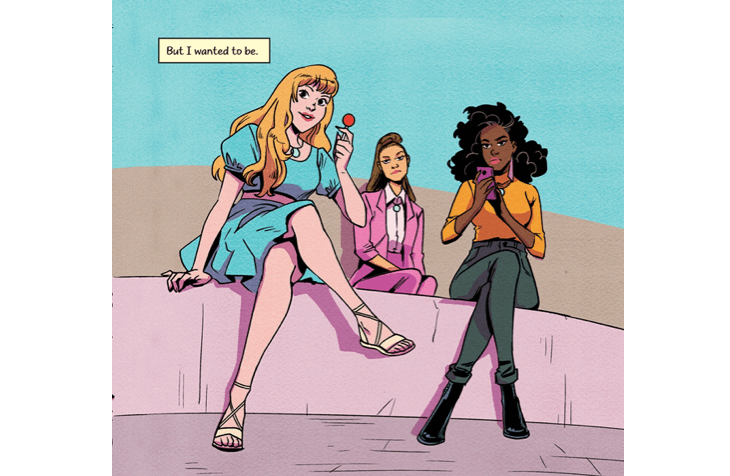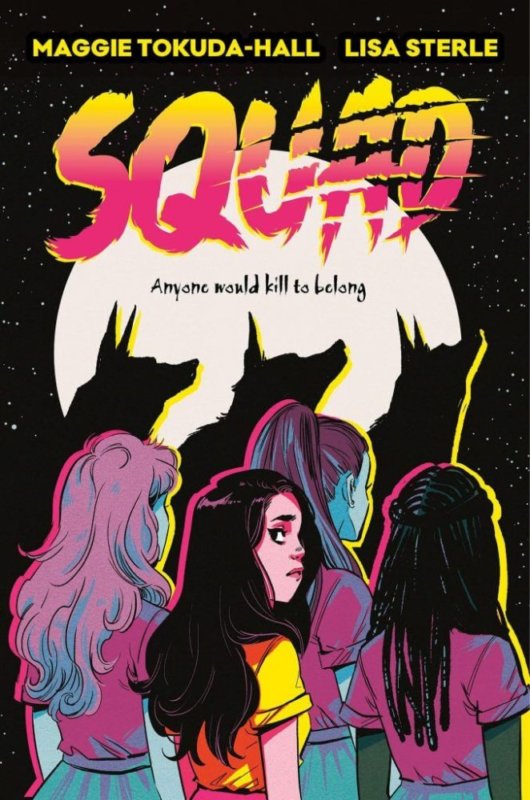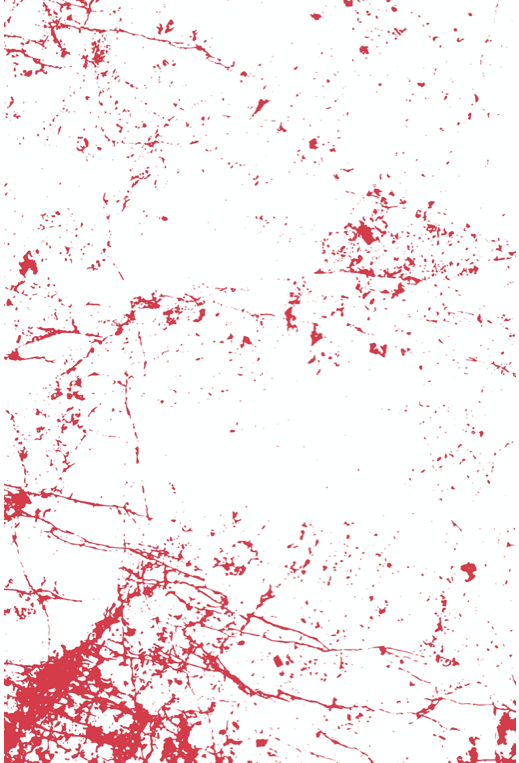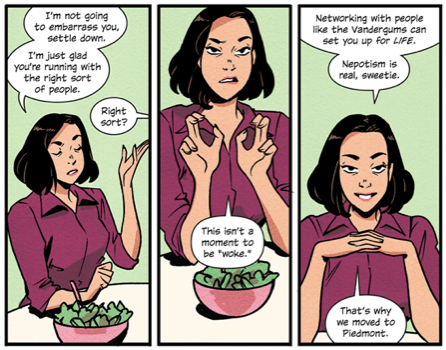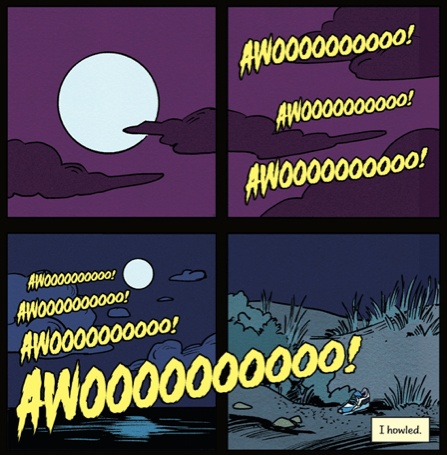A quote from Megan Abbot’s Dare Me made the rounds on Tumblr a few years ago: “There’s something dangerous about the boredom of teenage girls.” Maybe Maggie Tokuda-Hall and Lisa Sterle had that quote in mind as they penned Squad, an original young adult graphic novel following Becca as she finds cruelty and violence where she expected to find popularity.
Squad
Maggie Tokuda-Hall (writer) and Lisa Sterle (artist)
Greenwillow Books
October 5, 2021
After a chance encounter with Marley, Becca finds herself welcomed into a powerful clique. She is swept up in the whirlwind of new clothes, social climbing, and taking whatever power she can find. Because these popular girls aren’t just punishing people with gossip and cutting wit—they’re werewolves, and their favorite prey is teenage boys who prey on girls.
Tokuda-Hall’s biting dialog and Sterle’s stylish and bold artwork combine to tell a teenage horror story rife with complications. Becca exists in a pressure-cooker of influences—her mother’s desire for her to have an easy life, her friends’ desire to get their hands on whatever power they can and punishing skeevy boys in the process, and Becca’s own secrets—with no easy way out. Rather than being a story of empowerment and justice, Squad explores the repercussions of catharsis taken too far.
Alenka and Melissa decided to put their heads together to review this comic, and here’s their conversation below:
Alenka Figa: I want to talk about influences! There are some clear influences or even references here to films like Heathers, Mean Girls, and Jennifer’s Body. The cruelty and cutthroat nature of high school popularity always makes great horror fodder! How do you feel this comic fits into that sub-genre?
Melissa Brinks: I think it fits very well! There are so many visual and dialog moments that point to movies like the ones you mentioned in a way that really works for me. I really enjoy all three of those movies, but there’s more I want from each of them that I actually think was answered quite well by the themes in Squad. I love how cruel the girls are—not just Marley, Arianna, and Amanda, but also Becca—and how that cruelty is established early on and carries through to the climax. Squad doesn’t seem to be interested in handwaving the cruelty away as justice—even though it is often cathartic—which is something I really appreciate.
I think something like Heathers really leans into the darkness of being a teenager, and Jennifer’s Body really leans into the catharsis of teen violence, but Squad gathers both up into a reprehensible but still fashionable werewolf suit and lets you feel everything from the righteous fury to the disgust once you’ve gotten your way. In that sense, I’d say it’s more akin to the criminally underappreciated Ginger Snaps, another teen monster story focused on the experiences of girls. Like Ginger Snaps, there’s a mixture of catharsis in enacting the violence you’ve feared all your life, and the power trip that results from having that power. I really liked that complexity in Squad, and that the story made me a bit uncomfortable when I could see myself in it. While Heathers, Mean Girls, and so on are the most apt comparisons in tone, I actually think the feeling it left me with was a bit more Midsommar—catharsis can become monstrousness if unchecked.
Alenka: I am very much on the same page, although I still haven’t seen Ginger Snaps (I will get to it, it’s on my list!) It’s a small thing, but the blood splash patterns that preface each chapter title page create this ominous sense that violence and bloodshed are inevitable, and I loved the atmosphere that created. Even if we get to feel some catharsis as these girls exact violence against violent boys, we also know how likely it is that the situation will spin out of the girls’ control. The first chapter title is “Welcome to Piedmont,” and is paired with an image of a sucker, which I read as Buffy references. I think Buffy has a sucker on her first day of school (sucker, vampire pun, get it? Or is it “lollipop” on the West coast?) and the first episode of Buffy is called “Welcome to the Hellmouth.” When Becca sees the girls sitting on the bleachers and says that she wants to be part of a group more than anything, we know things are going to go a different way – this is not a do-gooder Scooby squad. The blood is coming. It’s a really cool, intense setup and I love that the comic digs hard into that horror, letting the catharsis become monstrousness, as you said.
Character motivations are pretty important to this story. The girls talk a lot about Hunger, and they don’t just mean the hunger they feel as werewolves. Social and class status mean everything to them, and that’s a familiar motivation from the films and other properties mentioned above. However, there’s also loneliness, and the lure of power that comes with being part of a squad. What did you think about the individual characters and their reasons for becoming werewolves?
Melissa: I think we needed the ability to feel that hunger ourselves for this story to work. If you’ve never felt any of the things the characters of this book feel, I think they’re going to only come off as monsters. But if you’ve experienced loneliness or injustice or mistreatment or isolation, I think you’re going to better understand why they end up becoming werewolves and why they enact their own sense of justice on people. And that level of identification, even if we wouldn’t act the way the girls of this book do, lets us reflect a little on our own desire for cruel retribution.
That said, I didn’t quite grasp the motivations of all the characters as well as I did Becca’s. I got the sense that Marley was the sort of outcast of the group before Becca arrived, so that may have been reason to join, but I’m less sure about Amanda and Arianna. I would have loved to see a little more backstory for them, especially Arianna, who felt like the most ruthless and callous of the bunch and yet also less complex. I’d also have loved for more of Amanda, whose friends won’t even call her by her preferred name? How about some justice within the friend group?
Alenka: I wonder if there are plans for a prequel to give more context to Arianna, Amanda and Marley’s stories. When they discuss Allyson, the lore behind the werewolf packs as well as our sense of what the girls’ friendship dynamics were like before Becca joined deepens, and I think there is unexplored territory there that would be interesting to dig into. I am biased toward queer characters but I would be very curious to see why and how Marley joined. She does feel like a bit of an outcast, and in Heathers fashion her non “A” name does single her out. She’s also immediately trusting of Becca and seems to want to bring her into the fold the most, which suggests some possible new kid camaraderie. I will say – if Amanda and Arianna’s stories had to be cut short a bit so we could have all the scenes with Becca’s mom, I am OK with it. Speaking of…
All the scenes with Becca’s mom really stood out to me. She has a line early in the story that really killed me: “Nepotism is real, sweetie. That’s why we moved to Piedmont.” That line underscores a lot of the character motivations but also reveals why Becca is the way she is. Becca understands her mother very well and reads between the lines of everything she says to find the nepotism underneath. However, there are also some very difficult, sweet moments where it’s clear her mom just wants Becca to make friends. While she’s not on the page very often, she makes a very solid impact on the story. What did you think about their relationship?
Melissa: I have very mixed feelings about it, but not in a way that reflects poorly on Squad — I think it’s really well done! Becca’s mom is not very likable in a way that makes her a strong, interesting character, especially as the rock to the squad’s hard place. Becca is caught between these two incredible sources of pressure, with the person who should theoretically love and support her instead feeling very shrewd and social-climby in a way that doesn’t seem to jive with Becca’s personality. Becca, like Marley, feels a little out of place in the squad, but it’s not hard to see how she ended up there with the influence of her mom, as well. Despite any pretense Becca might have of being different, the moment she sheds that really cool fringe jacket early on tells us that though she might push back against her mother’s suggestions of ass-kissing and social climbing, she wants to fit in, too. (Note: I bought a white fringe jacket after reading this comic. It’s “for my Halloween costume,” which is uh, a vampire cowgirl, but it’s also just because I thought Becca’s jacket was cool and I wanted one?}
Their fights, passive-aggressive and sometimes just aggressive as they are, are sometimes hard to read. I want Becca’s mom to be more conscientious of the kinds of unspoken messages she’s sending her daughter. I want Becca to have the security to push back on them without meanness. But these are two characters caught up in society’s pressures, as we all are — it’s not a surprise that they’re often cruel to one another.
I do need to talk more about the fringe jacket, though. In my reviews of Witchblood, I’ve often fawned over how Lisa Sterle draws fashion. What qualities do you think that her art brought to the story? Did it work for you overall?
Alenka: Sterle’s art feels like a perfect for this story to me! The talk of fashion immediately made me think of the scene in which the squad takes Becca shopping. Initially, Becca is wearing jeans and shirts that I thought were perfectly fine, but the other girls dress her up in dresses and skirts. After the shopping montage, there is a close up of their legs, showing how the hems of their skirts all line up perfectly. It’s simple but it has a clear, strong impact – Becca is letting herself be absorbed by this group, and it works. She can fit in this place, even if that doesn’t bode well.
Simple but with a clear and strong impact sums up my overall feelings about Sterle’s art for Squad. The backgrounds aren’t typically super detailed, and while there is violence gore, I didn’t think it was that graphic. Visually, the focus is squarely, solidly on these characters, the choices they are making, and how those choices are changing their lives, for better or worse. It works very well. My only issue was with the werewolf designs, especially at the end. At the climax of the story there are a lot of wolves roaming around at once, and multiple girls are shifting between wolf and human fairly quickly. Each wolf has a different fur color that matches each girl’s hair, but I still had a hard time telling them apart and following the action. Sterle definitely succeeds at imbuing the human characters with a unique personality and life, but the wolves blend a bit.
What did you think of the paranormal visuals – the blood, the violence, and the wolf fight at the end?
Melissa: I totally agree that it was a bit hard to parse what was going on toward the end. I liked it, and the ending satisfied me regardless of whether I knew exactly what was going on in the climax, but I do think that more distinction between the wolf forms would have been helpful. Maybe if we had spent more time with them as wolves, we might have been able to tell them apart a bit better? As it was, I just sort of relied on the following events to figure out what exactly happened in that last scene.
Other than that, I liked the wolf designs quite a lot; they felt appropriately wolfy without bringing to mind any other werewolf designs immediately. Sterle gives them almost this snakelike flexibility to their design that really stood out to me. They feel lithe and nimble as well as strong, and I can picture them quite clearly even when not looking at them.
I also thought the violence and blood were appropriate without feeling unnecessary or gross. I’m not particularly bothered by gore so my threshold is maybe a bit higher than usual, but I felt that because this story is focused on the thrill and corruption of power and violence, there was just enough gore to make the point without turning it into some sort of YA splatterpunk thing. You have to show at least a bit of the aftermath to avoid glossing over the violence of what they’re doing, and I think the amount they showed was successful at that.
Melissa: OK, this is my last and perhaps most important question: had you been offered this werewolf deal as a teenager, would you have taken it?
Honestly? I think I would have. I think that speaks to why the premise is effective for me — I was an often lonely, weird, and angry kid, and I think the connection and externalization of my feelings would have been really appealing to me. It’s not hard to put myself back into the mindset of Becca and the other girls, so even if the premise itself isn’t realistic, I can easily see how the promise of strength and camaraderie in exchange for requiring violence would be tempting.
Alenka: That is a really good question but I have the worst answer! I would not have taken the deal because while I was a nerdy, outcast sort of kid, I had a crew of also nerdy friends and very supportive nerdy parents, so I felt like I had a place where I belonged. I also lacked a certain kind of self-awareness and had all my identity crises when I was much older (I’m still having some of them, hah.)
Honestly, I think the werewolf deal is more enticing to me now than when I was a teen. Becca is immediately ripped and superstrong after taking the bite, and I have so many injuries and aches now that that kind of body transformation is extremely appealing. Only having to eat once a month would make me way more productive. There’s also the whole queerness/queer allegory bit – Becca is drawn to Marley, has a crush on Marley, finds companionship in Marley and the other girls by getting intensely involved in their whole werewolf deal. Isn’t that kind of like meeting a bunch of cool queer people as an adult and getting intensely involved in their whole playing D&D deal?
You know, I think I just talked myself into becoming a werewolf.

